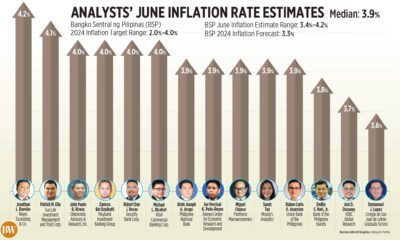Finance
Jobs and inflation rates could push the U.S. Treasury market out of narrow range
By David Randall
NEW YORK (Reuters) – A series of upcoming economic reports and congressional testimony from Federal Reserve Chairman Jerome Powell could push U.S. Treasury bonds out of a narrow trading zone.
U.S. 10-year Treasury yields, which move inversely to bond prices, have rebounded between about 4.20% and 4.35% since mid-June as the market digested data showing slowing inflation and signs of some indicators showed a slowdown in economic growth. The ten-year interest rate stood at 4.33% on Friday.
So far, economic data has failed to dispel doubts about the extent to which the Fed will be able to cut rates this year, keeping Treasury yields within a certain range. But next week’s US employment figures, followed by inflation figures and Powell’s actions could change that outlook.
“The market has entered a narrative that we may see increasing weakness, but not fear of growth,” said Garrett Melson, portfolio strategist at Natixis Investment Managers Solutions. “That will continue to keep us in this range, but the only thing that will push it significantly lower is an increase in the unemployment rate.”
US monthly inflation, as measured by the personal consumption expenditures (PCE) price index, was unchanged in May, according to a report published on Friday. This advances the story of slowing inflation and resilient growth that have curbed bond market swings and supported stocks in recent weeks. Still, futures tied to the Fed Funds rate showed traders had priced in just under 50 basis points of rate cuts for the year.
Market reactions to employment data, due next Friday, could be exacerbated by low liquidity during a week when many U.S. bond traders are on holiday for the U.S. Independence Day holiday, July 4, said Hugh Nickola, head of fixed income at GenTrust.
“The market is waiting for the other shoe to drop.”
A recent survey from BofA Global Research shows that fund managers are the most underweight on bonds since November 2022. Some believe yields could fall further as weakening data strengthens the case for more rate cuts and encourages greater allocation to fixed income.
Other highlights for the month include consumer price data scheduled for July 11. Powell will deliver his biannual testimony on monetary policy to the Senate Banking Committee on July 9, the office of its chairman, Sen. Sherrod Brown, said Monday. If tradition holds, the Fed chairman will deliver the same testimony before the House Financial Services committee the next day.
Some investors are not convinced that government bond yields will fall much further. Despite the recent cooling, inflation has proven more persistent than expected this year, forcing the Fed to rein in expectations about how aggressively it can cut rates. A recent unexpected recovery in inflation in Australia underlined how difficult it has been for some central banks to keep consumer prices in check.
At the same time, some investors believe that inflation is unlikely to return to pre-pandemic levels and the US economy is likely to exhibit higher levels of underlying strength, limiting the negative longer-term impact on bond yields. said Thierry Wizman, global FX and rates strategist at Macquarie Group.
“The market has become much more accustomed to the idea that when the Fed cuts rates, they won’t cut rates as much as people suspected a few months ago,” Wizman said. “People have adjusted their expectations, but there is a limit to how much revenues can fall as a result of a month of bad numbers.”
(Reporting by David Randall; Editing by Ira Iosebashvili and Richard Chang)









